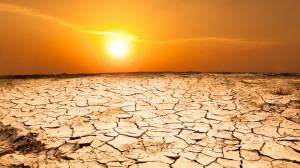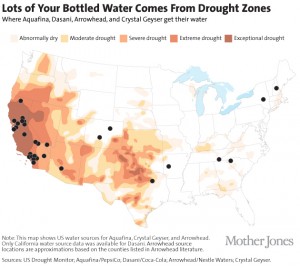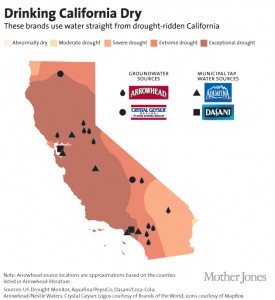Bottling Up Efforts to Conserve Precious Water?
Aug 14th, 2014 | By admin | Category: Water IssuesBy Suzanne York, www.howmany.org
Most Americans are probably aware that California and much of the U.S. Southwest is in the grips of a major drought. And it’s likely that people know at least something about conserving water. Take shorter showers, don’t wash your car, water your lawn at risk of $500 fines, etc.But a recent article in Mother Jones really highlights how out of touch the corporate world is with anything that requires cutting back. Business as usual is the dominant theme in society today. Change is for someone else to have to do, over there, not here, not me.
The story by Julie Lurie is “Bottled Water Comes From the Most Drought-Ridden Places in the Country.” The two maps included in her article paint a thousand words:
and for California:
What Were They Thinking?
One day, future generations – hopefully – will look back and wonder what the world in the early 21st century was thinking. The above maps clearly show that we are not thinking. Right now, California is still pursuing fracking, a polluting and water intensive industry because the powers that be will not make the right choices to put American on the path to clean energy. They are too beholden to the fossil fuel industry and other companies that seem to think only of profit and not long-term needs, such as clean air and water.
Lurie writes:
In the grand scheme of things, the amount of water used for bottling in California is only a tiny fraction of the amount of water used for food and beverage production—plenty of other bottled drinks use California’s water, and a whopping 80 percent of the state’s water supply goes toward agriculture. But still, the question remains: Why are Americans across the country drinking bottled water from drought-ridden California?
One main reason why California’s water is being tapped for the bottled water industry, Lurie notes, is that “California happens to be the only Western state without groundwater regulation or management of major groundwater use. In other words, if you’re a water company and you drill down and find water in California, it’s all yours.”
These are not your “Mom and Pop” businesses; the biggest bottled water companies include Dasani (owned by Coca Cola), Aquafina (owned by Pepsi), and Arrowhead (owned by Nestle).
As California struggles with a drought that affects the entire state, some decision-makers continue to push for ideas that are becoming absurd, such as Governor Jerry Brown’s love of the idea of building water tunnels to ship water from the Sacramento-San Joaquin Delta to southern California.
In November, California voters will be asked to authorize $7.5 billion to bolster the state’s water supply, infrastructure and ecosystems. Governor Brown, in response to the bond, said “the future of California needs a lot of water and we’ve got to use it in the best way possible.” Yet he supports water tunnel boondoggles and fracking, instead of looking for ways to sustainably conserve water in times of drought and beyond.
Buyer Beware
Ultimately, it is up to the consumer to stop purchasing bottled water, an unnecessary product in most of the U.S. that is not any safer than tap water.
The website for Harvard Law School lists the “Top Five Reasons Not To Drink Bottled Water:”
- Health – There’s no guarantee it’s safer than tap water;
- Greenhouse Gases – It’s greenhouse gas intensive to produce;
- Waste – Water bottles wind up in landfills;
- Money – Buying water adds up;
- Alternatives – Filtered tap water can be found in many public places.
Now, incredibly, we can add drought-intensive conditions to the list. Again the mantra for our world today – what were they thinking?
Suzanne York is a senior writer with the Institute for Population Studies.



